Killer Sudoku Online Weekly No. 381 - Flexing those flabby algebra muscles
Walkthrough by Steve Metzler (2013)
Last updated: 11th May, 2013
Update: reader Patrick Kelly informed me that working too far ahead on paper to find anamolies is frowned upon by the
purists. Always aspiring to be the purist myself, I reworked the puzzle to remove the wild-assed guessing, and that
eliminated four diagrammes as well :-)
Introduction
In my previous killer sudoku article:
Killer
Sodoku Online Weekly No. 371 - Mind Bending
We discussed the ground rules for this type of sudoku puzzle, tackled a really tough puzzle, and won out in
the end. The subject of this article is an equally tough puzzle, but for different reasons. Here, the solution
lies in figuring out a relationship between cells that is not exactly obvious... unless you know what to look
for, that is :-)
Solution
Here is the puzzle in question, with the initial 'gimme' cages filled in:
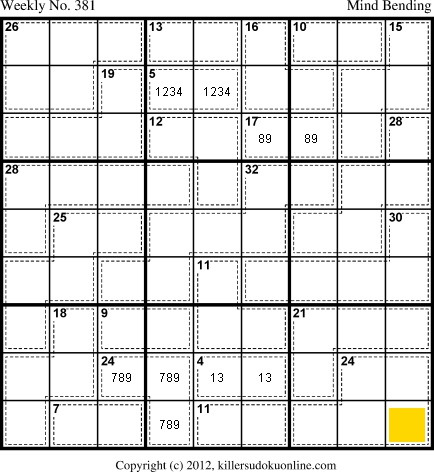 |
| Figure 1: Killer Sudoku Online Weekly No. 381 - Mind Bending. Initial stage |
The link for playing this puzzle on-line is at:
Killer Sudoku Online Weekly No. 381 - Mind Bending
Since we covered all the background last time, we're going to just dive right in this time. The key to this puzzle lies
straightaway with nonet F and its 'overflow' cells. Note that there are two 'outs' here: r3c9 and r6c6. And a single 'in':
r4c7. Since the sum of the cells in any nonet must be 45, there is an algebraic relationship between these 3 cells:
28 + 30 + r4c7 - (r3c9 + r6c6) = 45
Which reduces to:
r4c7 + 13 = r3c9 + r6c6
In plain English, this means that r3c9 + r6c6 must be 13 greater than r4c7. The fact that the {89} cage on r3 limits what
can go in r3c9 helps a lot to cut down the possibilities in this respect. Think about it. The least we can have in r4c7 is a 1,
so r3c9 + r6c6 must be at least 14. And since r3c9 can't be an 8 or a 9, that leaves us with:
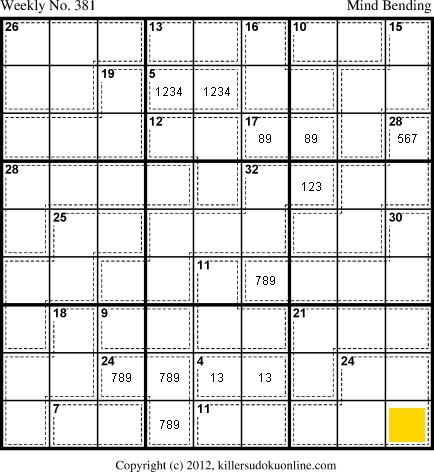 |
| Figure 2: Algebra. It works, bitc...! Ahem. |
Next we note that r3c9 is part of the 'ins' in nonet B + C. So r3c4 + r3c5 (part of the 12 x 3 cage) + r3c9 = 90 - (13 + 16
+ 10 + 15 + 5 + 17) = 14. According to the Sum Calculator, the possibilities for 14 x 3 excluding 8 and 9 are:
14 x 3 (x8,9)
------
167
257
347
356
We can immediately rule out {347} as a possibility here, because that makes the 5 x 2 cage in nonet B unviable. So now let's
look at all the possible permutations for filling in that 'hidden' 14 x 3 cage:
r3c4 + r3c5 | r3c9
----------- ----
16 7
17 6
25 7 (ruled out because we can't have two 5s in the 12 x 3 cage)
27 5
35 6
36 5 (ruled out because we can't have two 3s in the 12 x 3 cage)
Note that the overflow from nonet B is: (13 + 16 + 5 + 12 + 17) - 45 = 18. From the above, we know that r4c5 must be {345}.
But we can immediately rule out 3 as a possibility. If r4c5 is a 3, the remainder of the 12 x 3 cage can only be {27}. That
means the 5 x 2 cage must be {14}. Note that if r4c5 is a 3, then the 3 in the 4 x 2 cage below must be in c6. And that leaves
the only possible place for a 3 in c4 at r1c4, which is part of a 13 x 2 cage, and so is not possible. Now we can fill in all
the permutations of 18 in those three cells leaving us with {456} in r2c7. But the only way the 6 can get there is if r4c5 is
a 4. If r5c4 is a 4, then the remainder of the 12 x 3 cage is 8. And because of the hidden 14 x 3 cage on r3, r3c9 would have
to be a 6. Therefore, r2c7 cannot be a 6. So now we have:
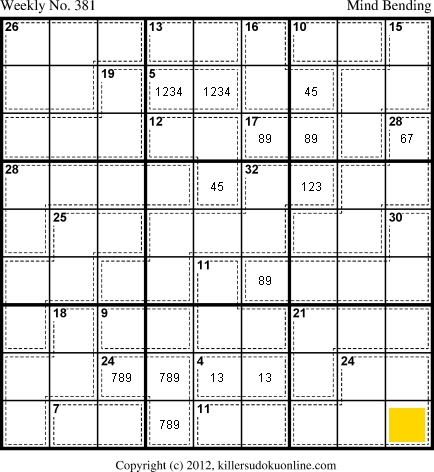 |
| Figure 3: The overflow from nonet B |
The 5 is now gone from r3c9 since r4c5 cannot be a 3, and a bit more deduction allows us to get rid of the 7 in r6c6. Do you
see it? Right. If r3c9 is a 6, then r6c6 cannot be a 7, as then those two cells would not be 13 greater than r4c7. If r3c9 is a
7, then r6c6 cannot be a 7 as well or there would be no possible way to put a 7 in nonet F :-) I thought I'd show you the state
of the board at this point in Figure 3 before we go further in narrowing down nonet B. Ready? OK then... if r2c7 is a 4, then the only
possible way to make 12 to finish off the 16 x 3 cage is with {57} (note how the two {89} cells in c6 block the only other
possibility of {39}). Likewise, if r2c7 is a 5, the only way to make the remaining 11 is with {47}. So the 16 x 3 cage must contain
{457}, and that limits the 13 x 2 cage in nonet B to {4589}. Since either the 13 x 2 cage or the nonet B portion of the 16 x 3
cage must contain a 4, then the 5 x 2 cage has to be {23}. That leaves {16} over to complete the 12 x 3 cage, and we have now
fleshed out the top 3 nonets considerably:
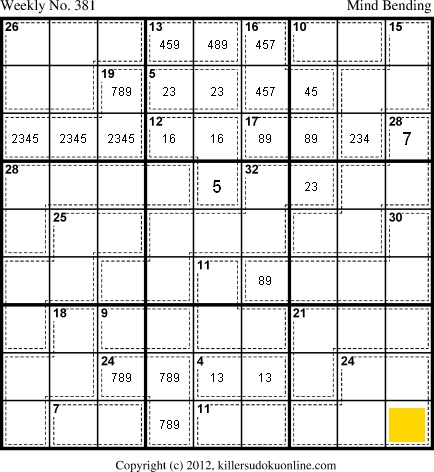 |
| Figure 4: Top 3 nonets taking shape |
Two items of note there, the first being that since the 19 x 4 cage in nonet A cannot contain {234}, then it must contain
the 5 on r3. Secondly, we have eliminated the 1 from r4c7 bcause of the '13 greater' rule. Now let's turn our attention to
the bottom of the board. The overflow from nonet H is: (11 + 9 + 24 + 4 + 11) - 45 = 14. That, coupled with the fact that
there is a hidden 20 x 3 cage (45 - (18 + 7)) in nonet G gives us the following possibilities there (because of the 20 x 3
cage, the minimum value r7c3 can have is 3):
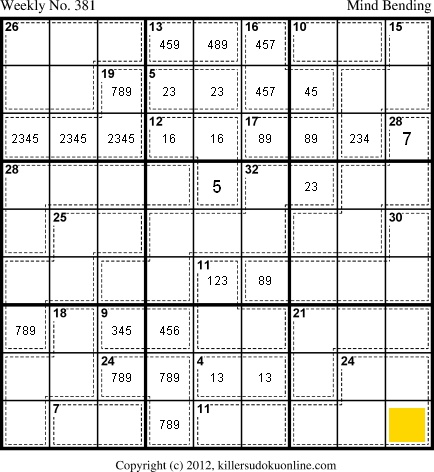 |
| Figure 5: On the fringes of nonet H |
Took a few liberties there while I was at it. r7c3 cannot be a 7, because the overflow out of nonet H would then exceed 14.
That also tells us that r7c1 must be at least a 7, because r7c3 + r8c3 can be no greater than 13. Next, the geometry of that
32 x 7 cage in the middle of the puzzle helps narrow things down quite a bit more. The Sum Calculator says:
32 x 7
------
1234589
1234679
1235678
Very handy indeed. Since every permutation contains {123}, that means that whatever is in r6c5 must also be in r3c7 as
there is no place else it can go. That eliminates the 1 from r6c5, and we are left with:
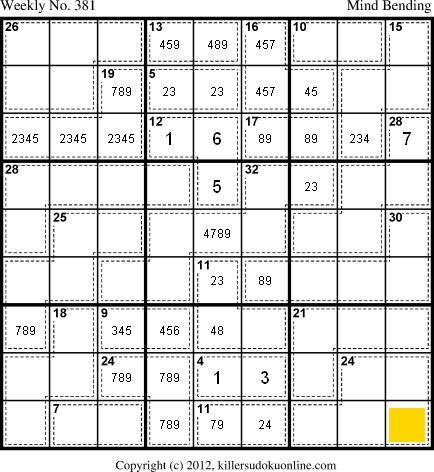 |
| Figure 6: c5 nearly cracked |
Take a close look at the 11 x 3 cage hanging out of nonet H. Note that there's no way to make 8 with what's already in nonet H,
so we can safely discard the 3 in r6c5. Then the only way to make 9 is with {45}. And there's another hidden cage in r7 to help us
close this one down: 90 - (18 + 9 + 24 + 4 + 7 + 11) = 17 x 3. So r7c1 must be an 8. All of this leads to a vastly improved view of
the board as below in Figure 7:
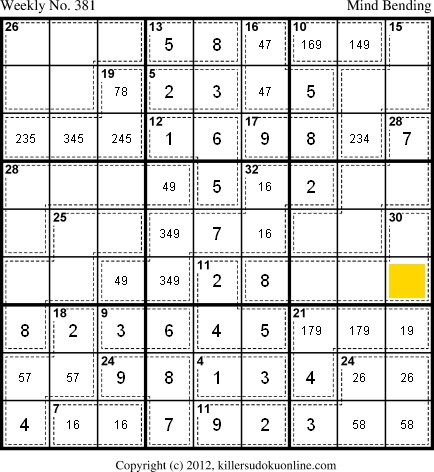 |
| Figure 7: Broken! |
The 21 x 4 cage in nonet I leads to a lot of that, and is nailed simply by running 21 x 4 (x3,5) through the Sum Calculator
after you determine that the r7 values in nonet I must be {1279}. Standard techniques will get you the rest. My work is done here.
Copyright © Steve Metzler 2013. All rights reserved. |

